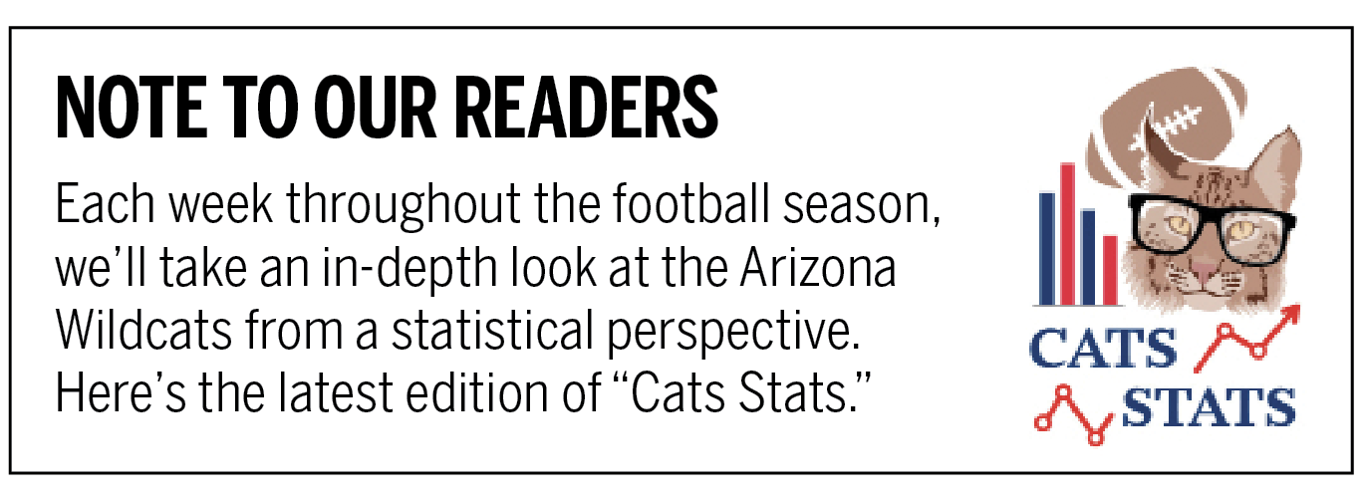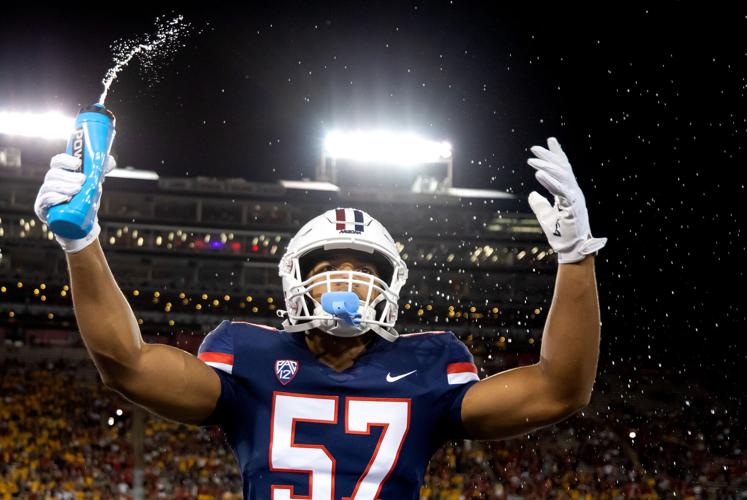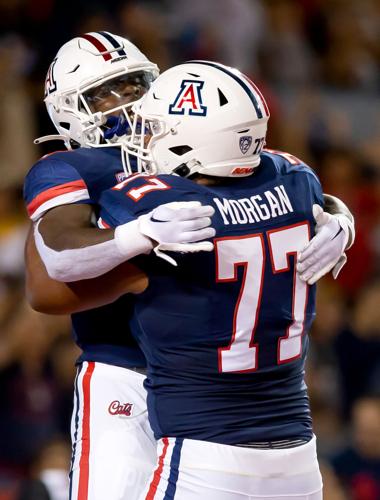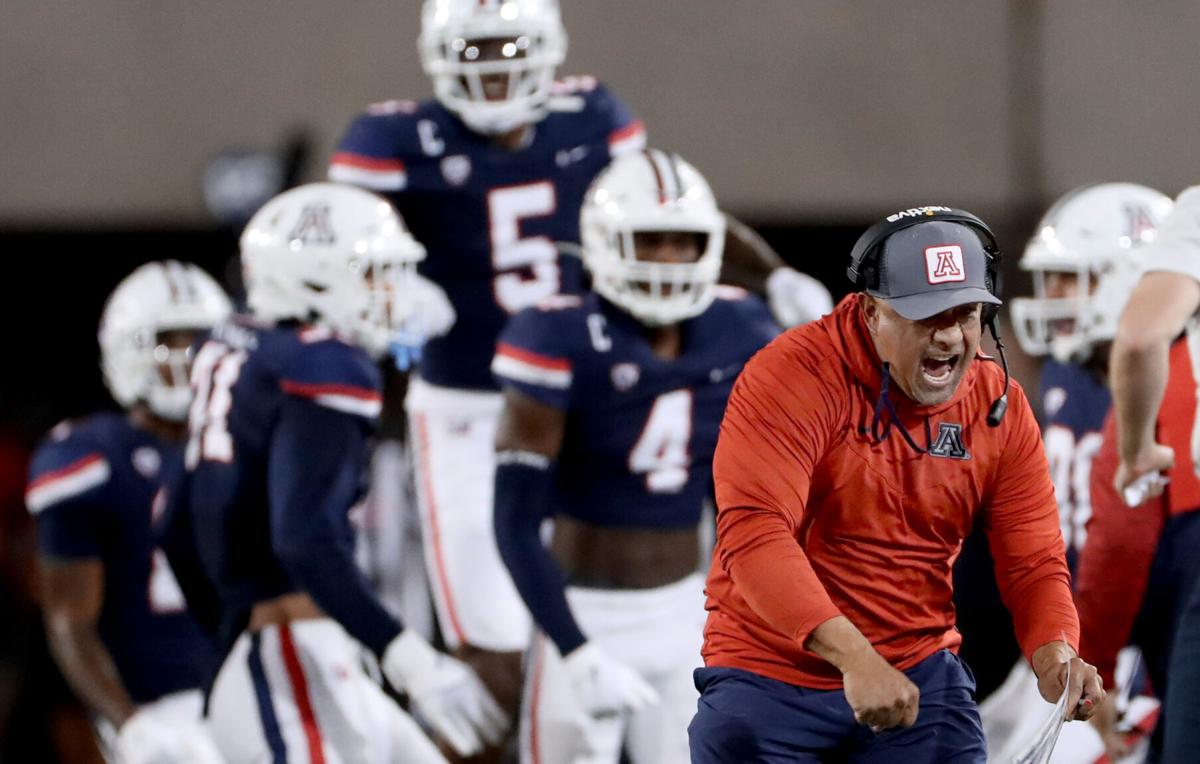The Arizona Wildcats are a quarter of the way through the 2022 regular season. They already have more wins than the previous two seasons combined.
Granted, the 2020 campaign was truncated because of COVID-19. But still: Arizona is making progress. The Wildcats are getting better. Their record says it. The eyeball test says it. The statistics say it.
When it comes to the numbers, where, exactly, has Arizona improved the most?
In this week’s pre-Pac-12 edition of “Cats Stats,” we’ll examine five areas where the Wildcats have shown significant growth.

UA offensive lineman Jordan Morgan celebrates with running back Jonah Coleman after Coleman scored a second-quarter touchdown against North Dakota State last season. UA head coach Jedd Fisch said Monday that Morgan, who suffered a torn ACL midway through near the end of last season, is "fully medically cleared" to play in Arizona's season opener Saturday against NAU.
The red zone
Arizona has gotten better offensively and defensively inside the 20-yard line.
The improvement on offense is stark. The Wildcats have scored touchdowns on eight of 11 trips into the red zone. At 72.7%, they’re tied for 47th in the nation.
As we all know, Arizona was by far the worst team in the country in that area in 2021 at 30.8% The Wildcats scored only 12 touchdowns in the red zone last season. They’re two-thirds of the way there one-fourth of the way through this year.
Before last week’s game against North Dakota State, four of Arizona’s five red-zone TDs came via pass plays. All three against the Bison were rushes. Being able to run the ball when you want to — when the opponent knows it’s coming — is something UA coach Jedd Fisch emphasized during the offseason.
On defense, the Wildcats have lowered their red-zone TD rate allowed from 76.3% (128th nationally) to 61.5% (75th). That might not seem like much, but red-zone stops of any sort can mean the difference between winning and losing. Case in point: Hunter Echols’ second-quarter strip-sack against NDSU. The Bison were at the 5-yard line. They got no points on that trip. They lost by three.
Turnovers forced
This was Item No. 2 on the offseason to-do list, and Johnny Nansen’s group has gotten it done so far.
Arizona already has matched its takeaway total from last season. But it goes beyond that.
The Wildcats had only three takeaways in five games in 2020. They had 15 apiece in 2018 and ‘19.
The last time Arizona was able to sustain a pace of roughly two takeaways per game was 2017. The Wildcats forced 25 turnovers in 13 games that year. That was also the last time they finished above .500.
There’s no guarantee the Cats will remain on this pace. More likely than not, given the luck factor involved with turnovers, they won’t.
But Fisch and Nansen have succeeded in instilling a mindset on defense. Fisch described it as “an absolute mentality that you go after the ball at all costs and at all times.” It’s working.

Penalties per game
Arizona had only one takeaway against NDSU — the aforementioned forced fumble by Echols, recovered by Jerry Roberts. But the Wildcats didn’t give the ball away a single time. Just as significant, they had only one penalty. That’s another area that’s trending in the right direction.
Arizona is averaging 3.67 penalties through three games, tied for eighth fewest in the country. Last year, Fisch’s first season, the Wildcats averaged 8.75 penalties – fifth most in the country.
Arizona’s season high in penalties came in Week 2 against Mississippi State, when the Wildcats were flagged six times. They had seven infractions or more in 10 of 12 games last season.
There isn’t necessarily a correlation between penalties and winning percentage. Thirteen teams are averaging four or fewer per game, and three have losing records (Navy, Boston College, Temple). Colorado has been flagged just 4.33 times per game and is 0-3.
Meanwhile, among the 11 teams that are averaging nine or more penalties per game, seven having winning records. That includes three that are 3-0: Alabama, Maryland and Syracuse.
But when you’re a rebuilding program like Arizona that’s just fighting for respectability, every little edge that you can carve out matters.
Sacks allowed
Arizona surrendered 35 sacks last season, the most in the Pac-12. Those plays resulted in 251 yards in losses.
This season, The Wildcats have yielded only four sacks for 39 yards in losses. This week’s opponent, Cal, ranks last in the league in both categories (12-97).
Is this a sign that the offensive line is performing better? To a degree. Arizona is allowing 14.3 QB pressures per game, according to Pro Football Focus. That’s down from 15.9 last season.
The biggest change is at quarterback. PFF has a stat called P2S% — percentage of pressures turned into sacks. De Laura is currently at 10%. The quarterbacks who played for the Wildcats last season combined for a mark of 19.4%.
Put another way: one of 10 pressures against de Laura is turning into a sack while roughly one in five became a sack last season.
De Laura is helping his offensive lineman just as much as they are helping him.

Arizona Wildcats linebacker Anthony Ward sprays water toward ZonaZoo during the second half of last weekend’s win over North Dakota State.
Average allowed per pass attempt
One of the strange elements of last year’s defense was that it allowed the second-fewest passing yards per game in the Pac-12 (190.1) while yielding the second-highest yards per attempt (8.1).
Arizona has lowered the latter figure significantly. Opponents are averaging 6.5 yards per pass attempt against the Wildcats. They haven’t finished a season below 7.0 since 2013.
Nansen’s defense has done a superb job thus far of limiting big plays. Arizona has yielded just three pass plays of 20-plus yards, tied for third fewest in the nation, per CFBStats.com. Only one play has gone for 30-plus yards – Hunter Luepke’s 31-yard touchdown on a busted coverage last week.
Last season Arizona allowed 33 passing plays of 20-plus yards – almost three per game. Almost half of those (16) went for 30-plus yards.
Cal has seven passing plays of 20-plus yards this season, tied for 98th in the country.








